Meerkat is a very clever animal that is well known for its character Timon in The Lion King movie. We have gathered complete Meerkat Facts For Kids that will help you in learning all the Meerkat Information For Kids that you need to know. You are going to learn about its scientific name & classification, evolution, appearance, physical features, physical abilities, diet, habitat, lifespan, reproduction, babies, behavior, adaptations, food chain, ecological role, endangerment, population, predators, and many other interesting facts about Meerkat.
Meerkat Facts For Kids
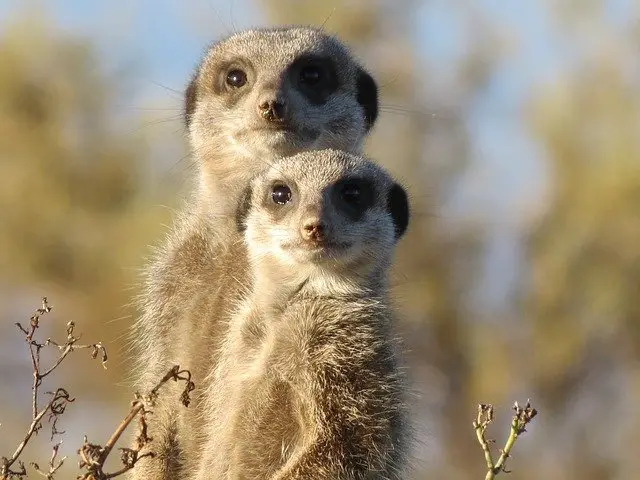
- Meerkat is a small mongoose species found in southwestern Africa.
- Meerkats are omnivores and consume a diet of both animal and plant origin.
- Meerkats have many structural and physiological adaptations, which help them to survive in the harsh climate of the desert. Such as thin coats of fur, dark patches around the eyes, sharp and large foreclaws, a special thermoregulatory system, and a lower metabolic rate.
- Meerkats are intelligent creatures and use complex coordinated behaviors that are often compared with chimps, baboons, and dolphins.
- Meerkats are highly social and live in the form of well-organized groups known as packs or mobs.
- All members of the pack perform different jobs and take turns on their duties. Some members stand up-right to watch for predators while the rest is foraging.
- Meerkats are immune to the venoms of snakes and scorpions. That is why they eat these poisonous animals without being hurt.
- Meerkat is one of the significant carriers of rabies and can transmit it to humans.
What Is A Meerkat
- The Meerkat is a small burrowing animal species belonging to the mongoose family Herpestidae.
- It is also known as a Suricate.
- Meerkats are found in southwestern Africa.
- They are well-known for standing on their hind limbs in the upright posture known as Sentinel.
- There are 3 recognized subspecies of meerkats.
- The populations of meerkats face no significant threats. That is why the IUCN Red List listed the species as Least Concern.
Scientific Name Of Meerkat
- The scientific name of the meerkat is Suricata suricatta.
Scientific Classification Of Meerkat
- The following is the scientific classification or taxonomy of meerkat:
| Domain | Eukaryota |
| Kingdom | Animalia |
| Phylum | Chordata |
| Subphylum | Vertebrata |
| Class | Mammalia |
| Order | Carnivora |
| Suborder | Feliformia |
| Family | Herpestidae |
| Genus | Suricata |
| Species | Suricata suricatta |
Evolution Of Meerkat
- In South Africa, the fossils of meerkats have been excavated in various locations that date back to 2.59 to 0.01 million years ago.
- A phylogenetic study in 2009 revealed that around 25.4 to 18.2 million years ago (Early Miocene), the mongoose family Herpestidae became split into two lineages; the eusocial and solitary mongoose.
- Meerkat is included in the clade of monophyletic eusocial mongoose along with several other genera and species of African mongoose, such as kusimanse (Crossarchus), banded mongoose (Mungos), dwarf mongoose (Helogale), and Liberian mongoose (Liberiictis).
- The solitary mongoose lineage consists of two clades, which include the species like yellow mongoose (Cynictis penicillata) and the Meller’s mongoose (Rhynchogale melleri).
- The genetic divergence of meerkat occurred 22.6 to 15.6 million years ago from the rest of the clade.
What Does A Meerkat Look Like
Appearance
- Meerkat is a small animal with a slim body.
- Its body is covered with soft fur, composed of guard hairs and soft underfur. The guard hairs are usually 1.5 to 2 cm long but maybe 3 to 4 cm long at the body sides.
- It has a broad head with a pointed snout, small nostrils, and large eyes, the sockets of which cover about 20% of the skull.
- Meerkats have small crescent-like ears at the top of their broadhead.
- They have a thin, slim tapering tail.
- They have long legs equipped with sharp and curved claws.
- Their foreclaws are slightly longer and sharper than their hind claws.
- Each foot of meerkats has 4 digits with thick pads underneath.
- Female meerkats have 6 teats.
- They have 36 teeth and a dental formula: 3.1.3.2 / 3.1.3.2.
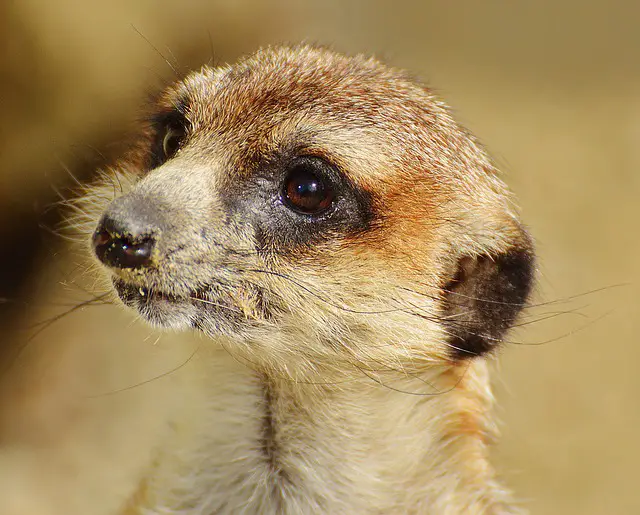
Color
- The coat color of meerkats ranges from light grey to yellowish-brown.
- At the back of their body, they have alternate light and dark bands.
- The guard hairs are light at the base, have two dark rings at the mid, and silvery-white or black at the tip.
- The head is mostly white with dark patches around the eyes.
- The underparts have dark skin and a thin layer of dark reddish-brown fur.
- The tail is yellowish-brown with a black tip.
- The coat color of the individuals found in the southern habitat range tends to be darker.
Physical Features Of Meerkat
Height
- The height of meerkats is about 25 to 35 cm (10 to 14 inches).
Weight
- The bodyweight of meerkats ranges from 0.62 to 0.97 kg (1.4 to 2.1 lbs).
- There is not much difference between the weights of males and females.
- However, some dominant females can be heavier.
Length
- The head-and-body length of meerkats is about 9.4 to 13.8 inches (24 to 35 cm).
- The tail measures 6.7 to 9.8 inches (17 to 25 cm).
Physical Abilities Of Meerkat
Speed
- Meerkats can run at the fastest speed of 32 km/h.
Jump
- Meerkats can jump while running and fighting their rivals.
- However, the vertical and horizontal distance they cover in a jump is unknown.
Climb
- Meerkats have strong non-retractable claws and muscular legs, which make them capable of climbing.
- They occasionally climb trees.
Swim
- Meerkats can not swim.
- They even do not like rainwater and hide in burrows if it is raining.
What Do Meerkats Eat – Meerkats Diet
In Wild
- Meerkats are insectivores and primarily eat beetles and lepidopterans (moths and butterflies).
- They also consume arthropods, reptiles, amphibians, small birds, and eggs.
- Meerkats also consume citron melons and dig out water-rich tubers and roots.
- Every day, they spend about 5 to 8 hours foraging.
- Meerkats prey through scent and often dig out the ground or turn over rocks to find hidden prey.
- Meerkats usually do not pursue their prey, however, they may chase lizards and geckos over several meters.
- The animal content of their diet mainly consists of about: 82% insects, 7% arachnids (spiders, scorpions, ticks, and mites), 3% centipedes, 3% millipedes, 2% birds, and 2% reptiles.
In Captivity
- At the San Diego Zoo, meerkats eat a special diet of ground meat made for captive carnivores, dry cat food, crickets, mealworms, and small amounts of vegetables and fruits.
- At the Smithsonian National Zoo, meerkats are fed with a commercial carnivore mix diet, cat kibble, crickets, earthworms, mealworms, root vegetables, and apples.
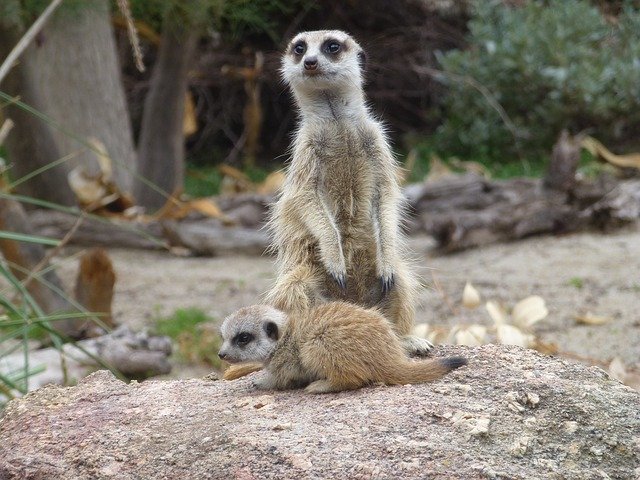
List Of Food Items
- The following is the list of food items that meerkats eat:
- Beetles
- Moths and butterflies
- Arthropods (such as scorpions and spiders)
- Amphibians (such as frogs)
- Reptiles (lizards, geckos, and snakes)
- Small birds (such as southern anteater-chat)
- Eggs
- Vegetables
- Fruits
- Roots and tubers
What Do Baby Meerkats Eat
- Baby meerkats consume mother milk for the initial 2 to 3 weeks of their life.
- At the age of about 3 weeks, they also start forging with adults.
Where Do Meerkats Live – Meerkat Habitat
Natural Habitat
- Meerkats are naturally found in southern Africa.
- They live in a variety of open and dry habitats with some woody vegetation.
- They are commonly found in open plains, rocky regions, and savannahs where the average annual rainfall is below 24 inches (60 mm).
- They prefer to live in regions with shrubs and short grasses.
- Predators and rainfall greatly influence the population densities of meerkats in a region.
- The home range of a pack is on average 5 km² (1.9 square miles) large. However, it may be as large as 15 km² (5.8 square miles).
- Mostly, the dominant individuals of the pack scent mark the border areas of the home range.
Burrows
- Meerkats dig burrows where they spend the winter nights and warmest parts of the summer days. They also use it as a birth den.
- A burrow is usually 16 feet (5 meters) in diameter and has about 15 openings.
- Their burrows are large underground networks that consist of two to three levels of tunnels.
- Usually, there is 8-hour insulation in the burrow, so that they are warmest at night and coolest in the daytime.
- The typical range of temperature inside burrows is between -4 to 26 ℃ (25 to 79 ℉ ) in winter and 21 to 39 ℃ (70 to 102 ℉) in summer.
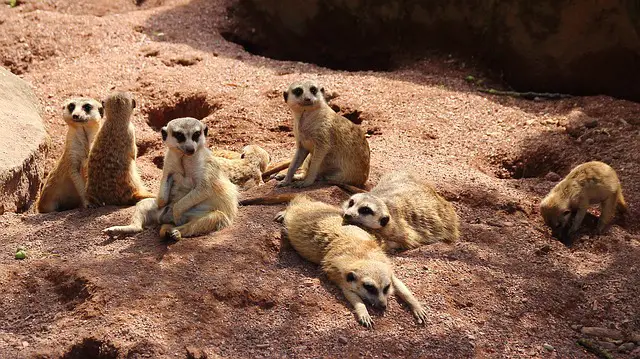
Biome
- Meerkats live in the biomes of savannah, shrubland (such as Fynbos), and semi-desert (such as the Karoo).
Range
- The habitat range of meerkats is; northern and western South Africa, southern and western Namibia, southwestern Botswana, and regions in Zimbabwe and Mozambique.
Countries List
- The habitat of meerkats is located in the following countries:
- South Africa
- Botswana
- Namibia
- Zimbabwe
- Mozambique
Meerkat Lifespan
In Wild
- The average lifespan of meerkats in the wild is 8 years.
- The range of their lifespan in the wild is estimated as 5 to 15 years.
In Captivity
- According to the San Diego Zoo, meerkats live for up to 13 years in zoos.
- Their recorded maximum lifespan in captivity is 20.6 years.
Meerkat Life Cycle
- The life cycle of a meerkat starts when they are born after a gestation period of 60 to 70 days.
- They sexually mature at the age of about 1 year.
- However, females start breeding at the age of 2 to 3 years.
- The females reproduce about 4 times a year.
- The average lifespan of meerkats in the wild is about 8 years. While they live for a maximum lifespan of 15 years in the wild.
Meerkat Reproduction
- Meerkats reproduce throughout the year.
- They breed cooperatively. Typically, dominant breeders in a pack reproduce while the non-breeding subordinate helpers help in taking care of the pups.
- Their breeding reaches a peak during the months of heavy rainfall. For example, in southern Kalahari, maximum births occur from January to March.
- Only dominant members in a pack reproduce. During the highly productive years, the subordinate members of the pack are also mates.
- A dominant female reproduces up to 4 times in a year.
- The gestation period lasts for 60 to 70 days.
- 3 to 7 pups are born in the form of a litter. The number of pups in a litter depends on the amount of rainfall or precipitation.
- Fathers guard their offspring while the non-breeding individuals of the pack also help to take care of the pups.
Meerkat Baby
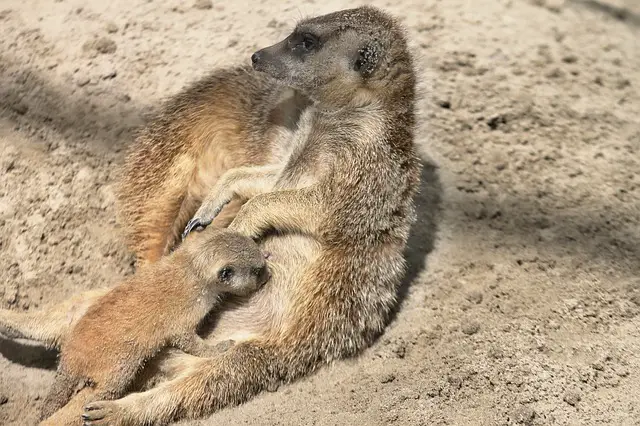
- Baby meerkats are known as pups.
- The newborns weigh about 100 g (3.5 oz).
- Mothers feed them with their milk.
- For the first three months, the average growth rate of pups is 4.5 g (0.16 oz) per day.
- Infants make sounds similar to tweets of the birds that alter to shrill contact calls as they are growing.
- Pups stay in a den from where they come out about 16 days after their birth.
- At the age of about 26 days, pups start foraging with adults.
- The pups look like adults when they reach the age of 2 months.
- Pups are weaned at the age of 6 to 9 weeks.
- The pups learn hunting skills and other behaviors through observations and mimicking the adults.
- At the age of 3 months, they become independent and do not need help in foraging.
Meerkat Behavior
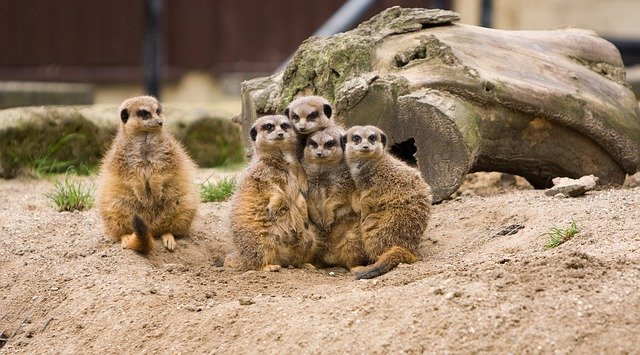
- Meerkats are eusocial animals and make highly organized social groups known as packs or mobs. A pack has 2 to 30 individuals and consists of pairs of multiple family units and their offspring. The number of male and female individuals in a pack is nearly equal. A pack’s members perform different jobs and take their turns, such as watching out for predators and taking care of the pups. Meerkats have a dominant hierarchy, and the social status of older individuals is higher than others.
- Meerkats are diurnal; spend the night in burrows and emerge once the sun is up. They spend some time sunbathing and grooming and then spend much of their daytime foraging.
- Meerkats dig wide burrows, which have many entrances and a network of tunnels. Their burrows also have boltholes, which are used for a quick escape in case of any danger.
- Meerkats communicate through various types of sounds. A shrill call is an alarming call that signals all the pack members to take shelter in case of danger.
- When foraging, a pack of meerkats disperse within 16 feet (5 meters) of one another and do not lose vocal or visual contact. They systematically forage in regions within their home range. During forage, some pack members stand sentry to watch for predators while the rest is busy foraging. Meerkats usually do not return to forage in a region until a week or more days after their last visit. This behavior allows a region to be sufficiently replenished with a food supply.
- Non-breeding members in a pack considerably help to take care of juveniles. They feed the pups and huddle with them to keep them warm. Female helpers are observed feeding female pups more than male pups, while male helpers feed both equally. Helpers are sometimes involved in a behavior known as false-feeding, in which helpers decide to not feed the pups and favor their requirements over those of pups. This behavior is common when food is not abundant.
- The father fulfills the duty to guard and protect his pups. While the mother spends much time foraging to produce enough milk for her pups. The mother remains close to her offspring and gives out repetitive calls and shrills to make sure that the pups follow her. Pups learn many behaviors through mimicking and observing the adults, however, adults also give them active instructions. For example, adults teach the pups how to handle poisonous prey like scorpions. They teach them how to remove the stinger from a scorpion and how to eat it.
- Female meerkats can discriminate among the odor of their relatives or kins and others. The ability of kin recognition facilitates cooperation among relatives and is also useful to avoid inbreeding. As inbreeding among relatives leads to negative fitness consequences, such as hind legs length, juvenile survival, and growth until independence.
Meerkat Adaptations
Physical Or Structural Adaptations
Thin Coat Of Fur
- Meerkats have a thin coat of fur, which allows heat loss and helps them to survive in the harsh climate of the African desert.
Dark Patches Around Eyes
- Meerkats have dark patches around their eyes, which reduce sun glare and help effective lookouts.
- It acts like the dark lines painted beneath the eyes of a baseball player.
Big, Curved, and Sharp Foreclaws
- Meerkats have highly specialized big, curved, and sharp foreclaws.
- Such claws make them able to efficiently dig burrows.
Closable Ears
- The ears of meerkats are closeable and they close them while digging.
- It protects the debris and dust from entering their ears.
Flexible Tail
- Meerkats have a highly flexible and slim tail, which provides them balance when they are standing in the upright posture.
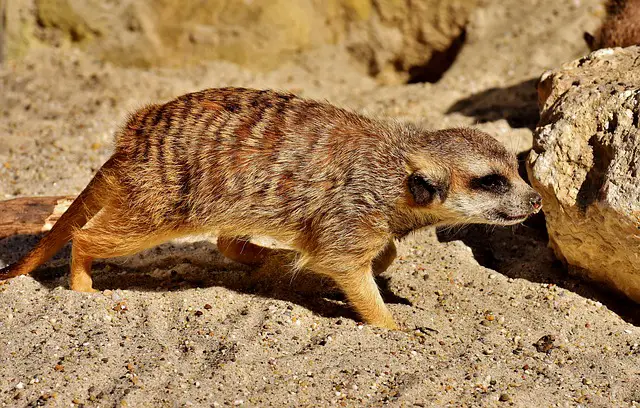
Physiological Adaptations
Specialized Thermoregulation System
- Meerkats have a specialized thermoregulatory system that helps them to survive in the harsh temperature of the desert.
- A study revealed that the body temperature of meerkats follows the diurnal rhythm. During the day, their average body temperature is 38.3 ℃ (100.9 ℉), while it is 36.3 ℃ (97.3 ℉) during the night.
- Their thermoneutral zone (the body temperature at which both the basal rate of heat production and heat loss to the environment is equal) has been determined to be 30 to 32.5 ℃ (86.0 to 90.5 ℉). Below this temperature, the oxygen consumption and heart rate rapidly decrease. While above this temperature, sweating or perspiration sharply increases.
Lower Basal Metabolic Rate
- Meerkats have a remarkably lower basal metabolic rate than other carnivores, which is an important adaptation in the harsh climate of the desert.
- It helps them to conserve water, survive on a lower amount of food, and also lower the output of heat from metabolic processes.
- During the winter season, the generation of metabolic heat increases balances the heat loss. They also use other methods such as sunbathing to control body temperature and stay warm.
Immunity To Snake And Scorpion Venom
- Meerkats have some immunity to the venom of scorpions and venomous snakes.
- That is why they kill and eat these poisonous animals without being hurt.
Sharp Sense Of Smell
- Meerkats have an extremely sharp sense of smell.
- They can find underground prey through their sense of smell.
- When they smell the prey, they quickly dig the ground and eat hidden prey.
Large Eyes
- Meerkats have large eyes that cover about 20% of their skull length.
- They have binocular vision, which allows them to perceive distances and depths.
- Their eyes also have a protective membrane that keeps their eyes protected from dirt while they are digging.
- Their eyes also have long and horizontal pupils, which give them a broad range of vision.
Meerkat Food Chain
- In the food chain of meerkats, the sun is the overall source of energy.
- Producers are plants that get energy from the sun and prepare their food through photosynthesis.
- Primary consumers in this food chain are insects and small mammals that consume plants and other things of plant origin.
- Secondary consumers are meerkats that eat insects and small mammals, such as rodents.
- Tertiary consumers in this food chain are the predators of meerkats, such as foxes, jackals, and raptors.
Ecological Role Of Meerkats
- Meerkats play an important ecological role.
- They are primarily insectivores and control the population of insects in their habitat.
- They also eat small vertebrates, especially rodents, and control the pest population in farms.
- They are a food source for other carnivores and hold an important place in the food chain and food web.
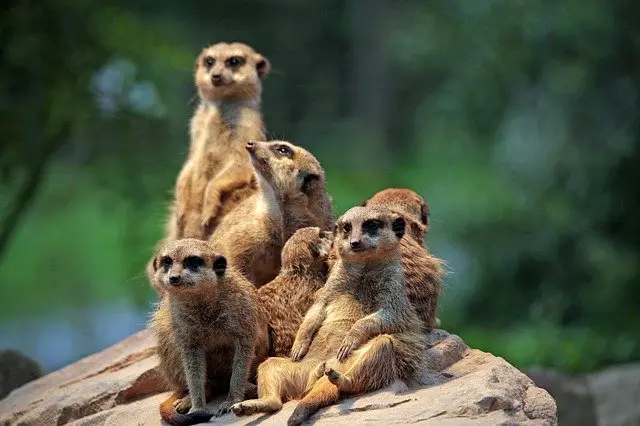
Meerkat Population
- The population of meerkats in the wild is unknown. No research has been carried out to estimate their number in the wild.
- The number of living meerkats in zoos around the world is thought to be 3,400 individuals.
Meerkat Endangerment
Reasons
- Meerkats are not endangered.
- Except for low precipitation or rainfall, there are no notable threats to the meerkats’ populations in the wild. Low rainfall sometimes led to the death of the entire pack.
Conservation Status
- The conservation status of meerkats on the IUCN Red List as Least Concern.
Meerkat Predators – What Are Meerkats Predators
- The major land predators of meerkats are; black-backed jackals, Cape foxes, and bat-eared foxes.
- Their major aerial predators are raptors, such as pale chanting goshawks, tawny eagles, martial eagles, bateleurs.
Fun Facts About Meerkats
- Meerkats are highly social and live in extremely organized groups known as packs or mobs.
- Meerkats dig temporary holes and safe places all-over their foraging area. These holes are known as bolt holes and they use to hide in an emergency.
- They are well-known for standing on the up-right position known as sentinel. They do so to watch for predators.
- The intelligence of meerkats is often compared with that of baboons, chimps, and dolphins.
- The harsh habitat of meerkats does not provide them water and they can survive without drinking water. They fulfill their water needs from the moisture found in the roots, tubers, and fruits they eat.
- Meerkats are immune to venom and can kill and eat scorpions and venomous snakes without being hurt.
- Packs of meerkats collectively migrate to avoid the high pressure of predators, in search of food, and during natural disasters (such as floods).
- The teeth and skeletal structure of meerkats and other mongoose have a close resemblance with those of the earliest carnivores.
Faqs:
Are Meerkats Cats?
- No, meerkats are mongooses, not cats.
- However, they are cat-like carnivores and belong to the suborder feliformia.
Are Meerkats Friendly?
- Yes, meerkats are friendly.
- However, they are social and live in groups.
- If removed from the group, they may be aggressive due to the stress.
Are Meerkats Dangerous To Humans?
- Meerkats may be dangerous to humans as they have a very strong bite if they become aggressive.
- Meerkats are also significant carriers of rabies and can transmit it to humans.
What Is A Group Of Meerkats Called?
- A group of meerkats is known as a mob.
What Is A Baby Meerkat Called?
- A baby meerkat is called a pup.
Do Meerkats Bite?
- Yes, meerkats bite.
Can A Meerkat Kill A Snake?
- A lonely meerkat can not kill a snake.
- Mobs or groups of meerkats are known to kill venomous snakes.
Do Meerkats Stink?
- Yes, meerkats have a very strong ferret-like smell.
How Much Do Meerkats Cost?
- A meerkat pet costs at least $1,000.
Why Do Meerkats Pee On Each Other?
- Meerkats pee on each other as part of the morning ritual.
Why Do Meerkats Stare?
- Meerkats stare at the threats and predators.
How Fast Can Meerkats Run?
- Meerkat can run at the fastest speed of 32 km/h.
Are Meerkats Intelligent?
- Yes, meerkats are intelligent.
- They have been found to use complex coordinated behaviors, which match that of baboons, chimps, and dolphins.




